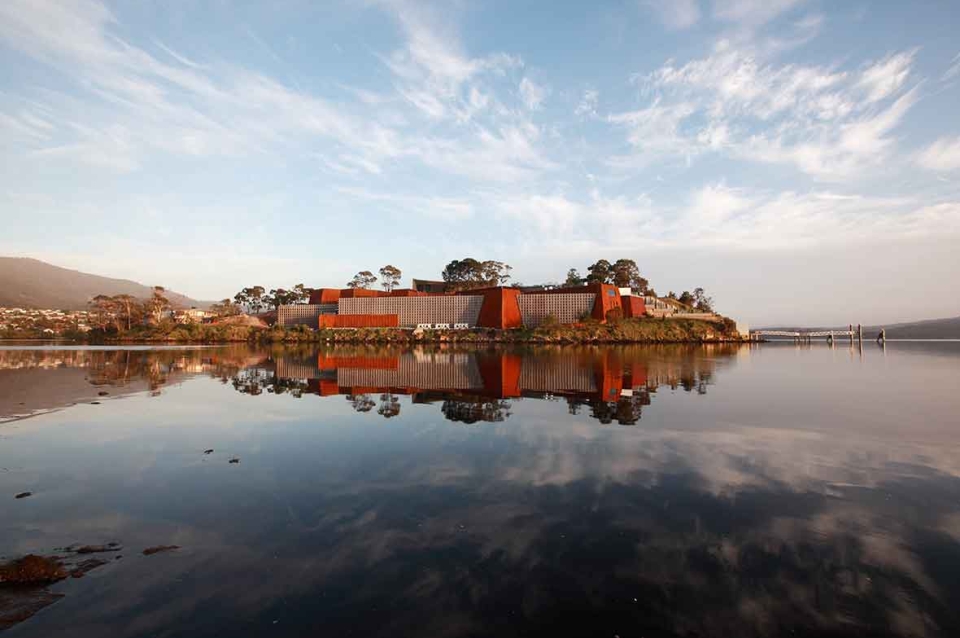January 19, 2016
The Air We Breathe

Photograph by Leigh Carmichael, courtesy of Museum of Old and New Art, Tasmania, Australia.
Stuart Weitzman School of Design
102 Meyerson Hall
210 South 34th Street
Philadelphia, PA 19104

Photograph by Leigh Carmichael, courtesy of Museum of Old and New Art, Tasmania, Australia.
Michael Grant
mrgrant@design.upenn.edu
215.898.2539
The new issue of LA+, PennDesign’s critically acclaimed interdisciplinary journal of landscape architecture, reminds readers of landscape architecture’s complicated relationship to the theme of pleasure, exploring the concept through art and design, science, philosophy, sociology, history, and geography. In an essay excerpted here, Architect Mark Raggatt takes readers on a visceral journey through the Mona (Museum of Old and New Art) located in Australia's island state of Tasmania. To subscribe, visit LAPlusJournal.com, or purchase single issues at OroEditions.com.
There are two ways to get to Mona: by road or by river. The MONA ROMA 1, a locally built catamaran, takes visitors up the Derwent River; the city gives way to eucalyptus and Triassic sandstone, a hint of the severe yet sublime landscape of Tasmania before a zinc refinery tumbles down to the water; a giant contraption from another time, all steam and pipes, gantries and trusses. Mona can be seen like the refinery's odd twin – it has an ancient bearing, as if exhumed rather than built. In fact, this isn't so far from the truth. The main building that forms Mona—designed by Melbourne architects Fender Katsalidis—has been cut into the peninsula, allowing the building to sit low to the water, an antipodean Petra.
The facade, more like a rampart, is a concrete grid. It recalls road infrastructure, military architecture. The grid is interrupted by rusting Corten steel bastions, there is no suggestion of the interior or clearly defined entry: the façade is not a mask, not intended to conceal, it's just blank, pitiless as if by nature. There is, of course, a fissure through which the visitor must climb between museum and rock. It's possible to run your fingers across stone that has seen mass extinction and the rise of mammals.
At the bar, Chinese tourists sit in Victorian furniture drinking wine, teenagers choose lurid macaroons from behind the glass, and I am still heading for the shit machine, the Cloaca. I'm in a ravine between sandstone cliff and blank white wall, a waterfall splashes words drawn from the day's most popular Google searches. Beyond, people play Ping-Pong on impossibly topographic tables. I pass through gilded galleries, brush red velvet walls, resist the temptation to lick the remains of a suicide bomber cast in chocolate, lose my balance in a labyrinth spelling Gilgamesh, watch the crumbling ashes of a giant Buddha, lust after a paunchy Porsche, and hurry past the casts of many vulvas.
It's feeding time for the Cloaca and I want a good view. Stepping out into the central void of the labyrinth of galleries, a Piranesian stair hangs with perilous dexterity within the concrete grid of column and beam. It sings out a dull clanging note when I step on it, it bounces a little, enough to feel the height should I fall, enough to feel the urge to leap out into the void. The stair reminds me of those diagrams illustrating the tunnels and passages within the pyramids, pointing out to a distant star, burying slaves within. I wonder if this stair points to some greater significance or if it turns back, lacking faith, preferring the travails of the present, the exigencies of circulation. This stair defies the grid, or rather takes advantage of its certainties. The grid is a trope in architecture; it denotes both pragmatism and endless possibility. The grid is democratic, being without hierarchy, the grid is libertarian, being naught but an empty frame. The grid can be pitiless, inexorable, and cruel. The grid, paradoxically, offers liberty and imprisonment. The grid at Mona takes the scale of a giant machine; like Cedric Price's Fun Palace (1961), it is an apparatus from which Mona's nightclub-style curation dangles in dark ludic joy, perverse, deathly, funny, democratic, and free. Art and architecture, not as an agents of happiness or fulfillment, but of change, of transformation, and therefore of unease.